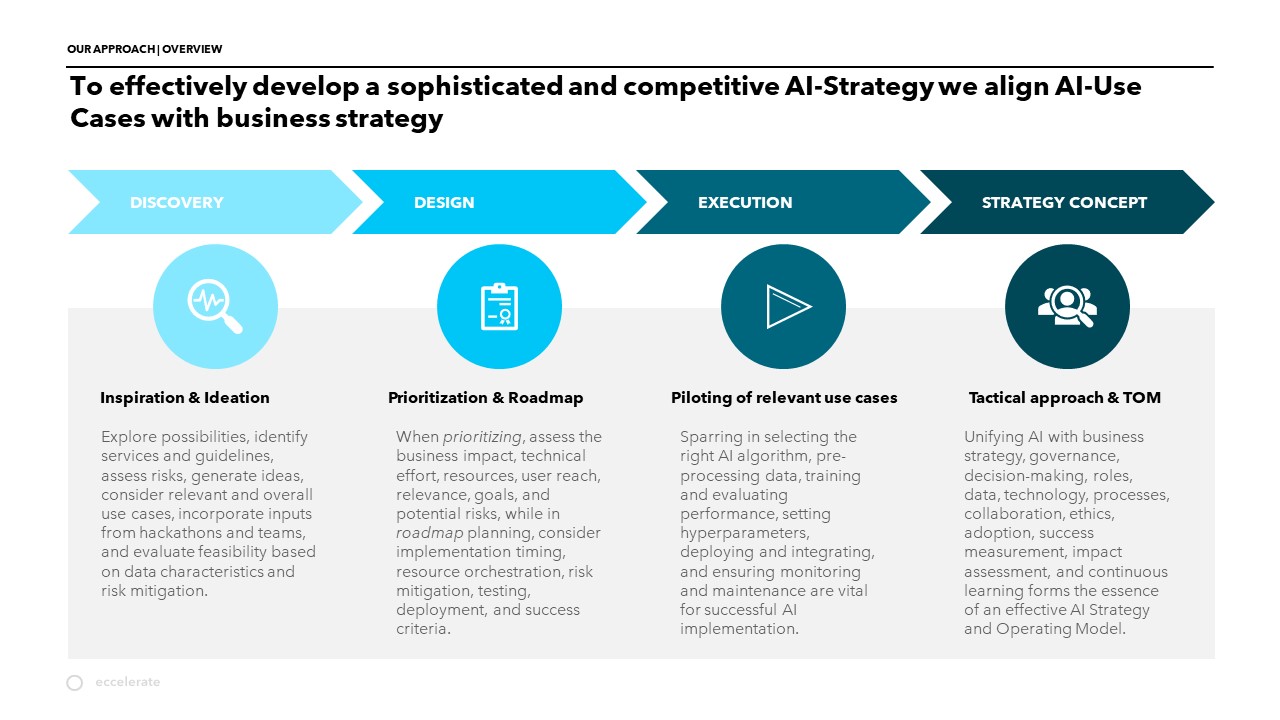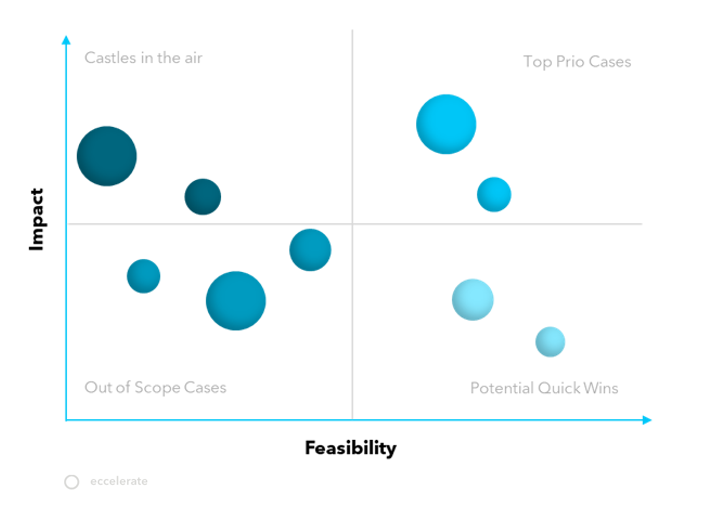
by Dominik Hennecke, Director & Practice Lead Analytics & Data Insights
Munich, May 2023
Current business realities present various obstacles, such as improving efficiency, making quick decisions, providing exceptional customer experiences, and staying ahead of competition. Failing to address these challenges effectively could put businesses at a competitive disadvantage and hinder growth. Implementing Artificial Intelligence strategies and technologies can be instrumental to helping businesses overcome challenges and thrive. AI offers advantages such as automation, optimized processes, improved decision-making processes, enhanced customer experiences, cost savings opportunities and predictive analytics capabilities that businesses may leverage to overcome the difficulties they are currently facing. Businesses implementing AI should follow a four-phase approach for its implementation: Discovery, Design, Execution and Strategy Concept. This involves aligning AI with business objectives, generating innovative use cases that fit with those objectives, assessing feasibility and potential impact, as well as planning implementation strategies. Furthermore, businesses must consider current capabilities, collaborate across domains, develop guidelines and frameworks and plan implementation accordingly.
Experience from our projects has shown us that clients are under increasing pressure to increase efficiency and productivity, make quick yet informed decisions, meet customer expectations for seamless experiences, and thus remain ahead of competition. Failure to address these challenges effectively could result in competitive disadvantage.
Main challenges:
To thrive in today’s business environment, businesses need strategies and technologies that boost efficiency, enable quick decision-making processes, deliver exceptional customer experiences, and maintain their competitive advantage. An AI – Strategy could assist businesses with mitigating these challenges.
Will AI really work for your business?
Businesses implementing AI may face several obstacles during implementation, including assuring data quality and availability, recruiting technical expertise, managing organizational change effectively, evaluating cost/return on investment calculations, complying with legal/regulatory requirements, gaining user acceptance/trust, scaling without user intervention while mitigating bias to drive positive business results – successfully steering through these obstacles is essential in unlocking AI’s full potential and driving positive business results.
Why implementing AI?
Implementing Artificial Intelligence can bring numerous advantages for businesses. It increases efficiency and productivity by automating tasks, optimizing processes, and helping organizations accomplish more with limited resources. Furthermore, AI plays an essential role in decision making, analysing large amounts of data to provide invaluable insight for making smart, data-driven choices.
AI can improve customer experiences through personalized interactions facilitated by chatbots, recommendation systems and personalization techniques powered by AI, leading to enhanced customer satisfaction and loyalty.
AI gives businesses an edge in today’s highly competitive environment by helping them innovate quickly, respond to market changes, and offer customer services and products tailored to evolving customer demands. AI also identifies cost-cutting opportunities, optimizes resource allocation, and reduces operational expenses across various business functions. Predictive analytics allow organizations to stay one step ahead of competitors using predictive models which enable proactive decisions.
AI also plays a pivotal role in risk mitigation, analysing large datasets to detect anomalies, patterns, or potential risks that would go undetected by humans alone. This allows businesses to better identify and address risks efficiently. AI can uncover hidden patterns, correlations and insights in complex datasets allowing organizations to gain a deeper understanding of their operations, customers, and market dynamics – providing invaluable strategic business insight that drives decision making processes. However, AI implementation presents businesses with additional obstacles. Businesses must consider data privacy and regulatory compliance issues, ethical considerations, talent acquisition/retention issues, integration with existing systems as well as manage resistance from employees/stakeholders to change.
AI implementation offers businesses significant advantages, transforming operations, decision-making processes, customer experiences and competitive positioning while mitigating external challenges.
Where can you begin?
Based on our project experiences, the most effective approach for creating an AI Strategy that benefits business is through four stages.

Discovery
In the Inspiration stage, businesses evaluate different opportunities available through artificial intelligence. AI offers businesses many potential benefits through automating processes, providing intelligent decisions making, and personalizing experiences for their customers. Companies can utilize various services, such as AI-powered chatbots, recommendation systems and data analytics. Strategic guidelines are vital to successful AI implementation, including aligning AI initiatives with business objectives, assuring data privacy and ethical considerations, and encouraging continuous learning and innovation. However, it’s also important to be mindful of potential risks related to AI implementation such as biases, breaches of data privacy or lack of transparency and accountability.
At the ideation stage, businesses can identify relevant use cases that meet their specific needs. These might include automating customer service processes or increasing demand forecasting capabilities. Furthermore, considering overall use cases can help optimize marketing strategies or increase employee productivity. Input from internal resources and teams are a valuable source for developing innovative ideas and offering diverse perspectives.
Businesses looking to implement AI should first assess the type and amount of available data. Sufficient data is crucial for training AI models effectively, while gathering all aspects and scenarios related to individual use case ensures comprehensive analysis. Retaining current sources will ensure AI models remain accurate. As part of an effective AI implementation strategy, it’s crucial to ensure reliable decision-making with accurate data. Assessing its quality and accuracy as well as its potential business outcomes helps prioritize use cases. Mitigating risks involves instituting robust data governance practices, guaranteeing data security measures, and addressing biases or ethical concerns that arise during implementation processes.
To ensure an effective implementation of Artificial Intelligence, it is crucial that organizations gain an in-depth knowledge of their current skill set, tech stack and organizational setup – this serves as the basis for seamlessly incorporating AI into existing processes and systems. Collaboration and input from all domains play an essential role in identifying key areas for improvement and outlining necessary action fields for successful AI adoption. Guidelines and frameworks are created to facilitate creating AI use cases more quickly. These guidelines offer businesses a structured method for identifying and evaluating use cases that align with their goals and objectives.
Businesses can improve their AI readiness and speed the speed of implementation for AI initiatives by understanding current capabilities, collaborating across domains, creating guidelines and frameworks, and using business insights from previous AI initiatives deployed across their organization – driving innovation and growth.
Design
Prioritizing each use case is critical to determine its potential business impact, understanding what value it could add to the organization. Assessing the technical effort necessary to implement a use case can provide important insight into its complexity and feasibility of implementation, along with any necessary resources like expertise, technology or budget that might be required. Deliberating on the user/customer reach of a use case is essential to understanding its audience and overall impact. Assessing its relevance to potential users helps establish whether it meets customer requirements and preferences. Setting clear goals and objectives for every use case ensures that its intended outcomes can be easily quantified. Assessing potential risks such as data privacy concerns or user consent issues is vital in prioritization processes.

At this stage, it is critical to establish the optimal timing and implementation approach for the most pressing use cases. Coordination resources effectively to implement multiple use cases may increase efficiency while speeding up deployment process. Mitigating potential risks should be an ongoing priority throughout a roadmap’s design, with proactive measures taken to assess and address them during implementation. Test and deployment schedules are created to ensure use cases are thoroughly validated before being released to users. A use case is considered successful when it meets its desired goals while producing tangible benefits such as increased efficiency or customer satisfaction.
Execution
Implementing an AI solution involves several key considerations during implementation. Determining the most applicable algorithm or model depends heavily on factors like problem nature, available data, and desired outcomes – these must all be carefully considered when selecting an appropriate AI algorithm or model for any particular use case. To prepare input data for an AI algorithm, various pre-processing steps such as cleaning, normalization, feature extraction or transformation may need to be undertaken to create an appropriate format for processing by the algorithm. Training an AI algorithm requires selecting relevant and representative data that covers patterns and insights necessary for it to learn, make accurate predictions or decisions and predictions. Training an AI algorithm entails exposing it to training data, then optimizing its internal parameters and weights accordingly to optimize its performance. Techniques such as supervised or unsupervised learning, reinforcement learning, or transfer learning may be employed depending on the nature of the use case and available data. Evaluation of an AI algorithm’s performance against desired outcomes or ground truth data is important to its overall effectiveness.
Validating the performance of an AI algorithm involves testing its ability to generalize on new, unfamiliar data sets. Cross-validation or hold-out validation techniques may be employed to ensure that it performs well even with new examples that it has never seen before. Integrating and deploying artificial intelligence algorithms into any target system or application requires careful planning and execution. Integrating an algorithm into existing infrastructure involves several considerations, including compatibility and scalability testing as well as any dependencies or technical restrictions that may exist. Once deployed, an AI algorithm must be continually evaluated and maintained to ensure its continued performance. This may involve monitoring its outputs, analysing its behaviour, and making updates and adjustments based on changes to data patterns or business requirements. Regular maintenance updates ensure the algorithm remains accurate, robust, and aligned with business goals.
For the successful selection and training of an algorithm, several steps are key to its implementation. At first, algorithm selection should consider the problem domain, data available, and desired outcome. This allows for selection of regression, classification, clustering neural network or reinforcement learning algorithms. Once identified, methods for dealing with missing data, outliers, normalization, and feature scaling must be determined to ensure data quality and compatibility with algorithms. A training dataset with relevant size, diversity and quality criteria must then be selected as part of its identification. Suitable evaluation metrics such as accuracy, precision, recall, F1 score or mean squared error should be defined and used to unbiased evaluate the model. Finally, robustness, stability, and potential overfitting or underfitting issues must be validated to ensure its effectiveness.
Once we have successfully implemented and tested initial use cases that have proven their utility and meet business goals, the question becomes apparent: What happens next?
How to Implement AI Sustainable into Your Organization?
To successfully integrate artificial intelligence (AI) into an organization, several important considerations need to be met. First and foremost, it is crucial that AI initiatives align with an organization’s overall business strategies and objectives to meet long-term goals effectively. Artificial Intelligence can create competitive advantage and differentiation by facilitating innovative solutions, improving operational efficiencies, and providing personalized experiences for customers. Establishing a governance structure and accountabilities are crucial to oversee AI implementation and ensure its responsible and ethical use. Decision-making processes for AI projects should also be clearly established to promote transparency, accountability, and informed decision-making processes. AI initiatives need a diverse team of roles and skills – AI experts, data scientists, domain specialists, business stakeholders – to succeed. Responsibilities should be divided among teams and stakeholders to encourage collaboration while maintaining efficient project management. Data governance and quality measures must be put in place in order to guarantee the accuracy, reliability, and integrity of AI projects. Adequate technology infrastructure and platforms must also be in place in order to support such initiatives while also allowing efficient data processing and model deployment. Integrating AI initiatives with existing business processes and systems is crucial to realizing their full value and impact. Collaborate between AI teams, data scientists, and domain experts for successful AI implementation. Leverage their expertise and insights for maximum benefit of successful AI implementation. Ethical considerations and guidelines must be implemented in order to maintain fairness, transparency, privacy protection and compliance with regulatory requirements. Communication strategies and plans must be put in place in order to facilitate AI’s adoption within an organization, including training, education, and change management initiatives. Measure and evaluate AI initiatives using key performance indicators (KPIs) and metrics aligned with their business objectives. Assessing their effect on business outcomes, efficiency, customer satisfaction and continuous learning and improvement initiatives as a measure of their effectiveness should also be implemented into an operating model to adapt to changing challenges, technologies, and business needs.
In order to successfully implement artificial intelligence, it’s crucial to employ a comprehensive strategy. This means taking lessons learned from previous phases, and compiling information that can inform future steps. Target operating models are essential in aligning implementation efforts with organizational objectives and context, and must clearly outline roles, responsibilities, and reporting structures to establish accountability for smooth implementation. Decision-making, governance, and collaboration processes must be clearly laid out to streamline operations and enhance effective communication. A change management plan must also be developed in order to accommodate any cultural or organizational shifts that may emerge during implementation. Communicating the benefits, rationale, and expectations of your target operating model to stakeholders is key to winning their support and obtaining their buy-in. Establishing KPIs and metrics will enable accurate measurement of an operating model’s success and offer insights for continuous optimization. Finally, mechanisms should be put in place for ongoing performance monitoring and evaluation to ensure its efficiency during AI implementation.
Final thoughts
Implementing AI into business poses many unique challenges, including data quality issues, talent acquisition issues, ethical considerations, and change management issues. AI offers many benefits to businesses. These include increased efficiency, enhanced decision-making, enhanced customer experiences, competitive edge, cost savings, predictive analytics risk mitigation solutions and valuable business insights. Businesses looking to implement AI should adopt a four-phase approach when beginning to shape a sustainable strategy: Discovery, Design, Execution and Strategy Concept. This methodology involves aligning AI with business objectives while creating innovative use cases, assessing feasibility and potential impact before planning its implementation. At this stage, it is crucial to assess current capabilities, collaborate across domains and establish guidelines and frameworks. Execution includes selecting an algorithm, gathering data preparation requirements, training personnel on these algorithms, evaluation, deployment and maintenance. To implement AI sustainably, businesses should align it with their overall strategy, create governance structures and processes, acquire roles and skills necessary for implementation, ensure data governance and quality, invest in technology infrastructure, integrate existing processes into AI solutions, facilitate collaboration while adhering to ethical guidelines as well as driving adoption with KPIs and ongoing learning programs.



© eccelerate GmbH